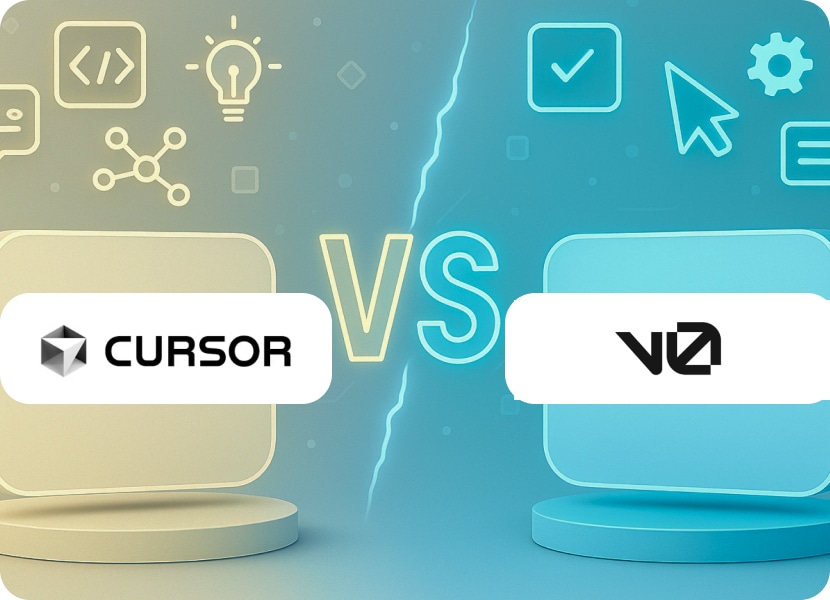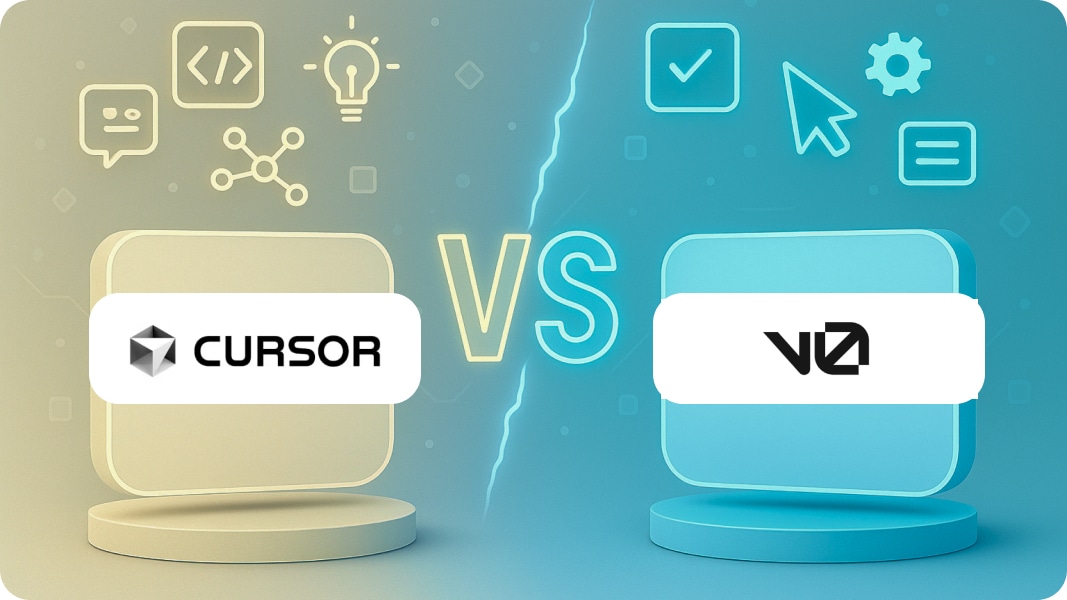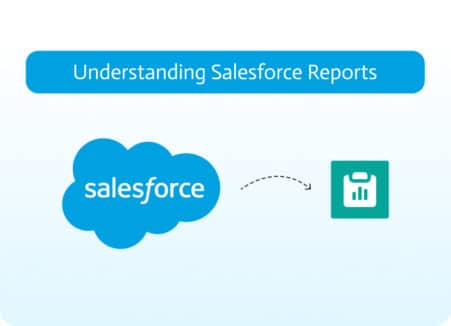

Cursor vs. V0: The Code Whisperer vs. The UI Wizard
Let’s get to the point: comparing Cursor vs. V0 is like comparing a bike to a car. Both are great tools for getting you to where you need to go, but they have slightly different visions on how to achieve it, and if you choose the wrong one, you’ll be angry before you can say “regenerate response.”
In full tests, Cursor scores around 2.9 points better than V0 when it comes to the writing of code. Cursor also just came out with Composer, its first in-house LLM, that can finish most tasks in less than 30 seconds, which is four times faster than other smart systems. At the same time, V0 by Vercel has slowly stolen the hearts of designers and frontend developers because they can now make production-ready React components just by describing them.
In the Cursor vs. V0 vibe coding fight, it’s about whether you need a full development system that assists you in writing code or a specialized UI generator that makes beautiful interfaces for you. SO, let’s go ahead and pick apart their vibe coding superpowers with the care they need.
Cursor vs. V0: The Basic Identity Crisis
Here’s something that no one tells you right away about the Cursor vs. V0 comparison: even though both are called “vibe coding platforms,” the ways in which they work are completely different.
V0 is an AI coding generator that makes full UI parts or apps using language prompting. You tell it what you want, and it makes code that is ready to use. Code generators like V0, Noca, Lovable, Bolt, and Replit are great for quickly making things from scratch, which is great for prototyping and getting started quicker than we’ve ever thought possible.
Cursor is a coding tool that undoubtedly makes life so much easier, especially when working on your projects in an IDE. It suggests code, helps you find bugs, and fills in the blanks intelligently as you write. Cursor and GitHub are examples of coding assistants that are more about improving your processes. This makes them pretty good for professional devs working on extremely complicated, long-term projects.
This difference is more important than you would think. V0 is for people who need UI parts made right away. Cursor is for programmers who want AI to help them along the way while they code. One makes things for you. The other person makes things with you when working together.
V0’s Vibe Coding Magic
V0 is Vercel’s AI-powered tool for quickly making UI prototypes. It turns descriptions in plain English into production-ready React components with CSS styling that works with shadcn/ui for easy project implementation.
What Makes V0 Interesting
The platform is fantastic at making landing pages, hero sections, and all those animation-rich parts that look phenomenal in seconds. Developers say they can now make whole landing pages with parallax effects, pricing tables, and testimonial sliders with just one prompt, and that’s not an exaggeration either, that’s how the work gets done today instead of tomorrow.
V0 turns descriptions into React items, fully ready for deployment. You’re able to upload design mockups or Figma files, and V0 turns them into a working script, making it a ton less complicated for designers to hand off their work to developers. One developer on Reddit talks about how V0 makes designs that are mobile-first, easy to operate, while meeting WCAG standards without any extra work.
The platform works directly with Vercel’s deployment pipeline, which lets you see design changes right away. Because everything is so well connected, you can outline your intended UI, write the code, see the results, and deploy them all in a matter of minutes.
The idea works in the real world. An e-commerce startup with few engineers used V0 to make a prototype of their entire product catalog interface in just one afternoon. With the old school ways, it would have taken their small team more than a week to do the same thing.
Where V0’s Vibe Coding Hits a Wall
The platform only works on the front end; it won’t make a backend for you. You are getting UI, not business logic, database operations, or server infrastructure. V0 is best for small, quick projects like personal homepages, simple tools, or quick ideas that don’t need a lot of logic.
Users say that V0 is able to make the code, but sometimes that doesn’t work, and sometimes it doesn’t finish generating all the code, and usually messes up the dev process. Code that is generated is not always of high quality, and it needs a lot of fine-tuning so that the needs of a specific project is fitted in somehow. V0 is powerful, however, it probably needs to be manually improved for interactions or accessibility compliance. As a result, large code blocks may need to be stripped down or debugged.
One user stated this best: “Been vibe coding for 5 months, but went back to no-code.” It was tiring to solve problems and repair AI-generated results because they were so unstable, and long-term maintenance was even scarier.
Taking Apart Cursor’s Vibe Coding Skills
Cursor is a completely different way of doing things. It’s a full IDE built on top of VS that provides AI features straight into your environment. Cursor improves every part of the coding process, unlike V0, which only focused on generating components.
What Makes Cursor’s Vibe Coding So Great
Cursor acts like it knows everything about your project, which lets you make smarter changes to multiple files and get more detailed help. This ensures that devs feel a lot more supported and guided throughout their work because the platform has built-in AI chat and a project-wide understanding. Cursor understands the whole project, not just the files, like VSCode’s AI.
The new Composer LLM is a big deal. Composer has intelligence that is on the same level as mid-frontier systems, but it has the fastest generation speed of any class that has been tested. It is said to be four times faster than other systems, finishing most tasks in less than 30 seconds.
Cursor’s inline suggestions know how to use frameworks such as Tailwind and can make layouts that are super responsive with the right HTML5 framework. Reddit developers say that “using Codex for detailed stuff…just does what needs to be done and does it well” in vibe coding discussions.
The platform has smart code completion that gives suggestions, a chatbot for guidance and debugging, and is able to comprehend the meaning of multiple files across entire projects. Cursor got a lot better in 2025. The updates made it even better at automating coding and have proven to be a massive help in terms of saving devs time on big projects.
When Cursor Gets Tough
Since the cursor only stores information relevant to the current session, it is possible that project-specific context will be erased when the session ends. Code that is generated can be sloppy, and a slight change could inadvertently break things that already work. Cursor may make mistakes while automating boring tasks, so managers should be extra careful to ensure that everything stays on the right track.
Developers who are more accustomed to the older editors will need to make some changes to the platform. Cursor is best for beginners and people who are willing to try out new ways of coding. However, experienced programmers may have to learn a little bit more about it.
Some developers say that Cursor could possibly be a little sluggish or feel heavier on bigger projects, and you have to pay for powerful features like enhanced AI functions.
Cursor vs. V0: The Vibe Coding Decision Matrix
Let’s make this very easy.
Choose V0 when:
- You need UI parts for front end made right away
- Your infrastructure is already there and works well.
- The most important things are rapid prototyping and visual iteration.
- You want to deploy without any problems in the Vercel ecosystem.
- The main problem is the design handoff.
- Budget lets V0 set prices according to credit.
Choose Cursor when:
- You’re writing code for the whole stack.
- It needs to get the context of whole projects.
- You want artificial intelligence help but still want to be in charge of coding.
- You work on complicated, long-term projects.
- You need comprehensive development assistance beyond UI generation
- Your work uses a lot of different languages.
Vibe Coding in Tandem
An effective way to handle the Cursor vs. V0 debate is to use both at different points in development.
This is a great example of how one developer spends their weekends: “My vibe coding process starts with imagining what I want to make, starting with quick mockups in V0. Cursor, my AI-powered IDE, connects to Claude 3.7 to make code and fix bugs. I can set up preview environments with Vercel in five minutes.
Design teams use V0 to test out different visual directions for interfaces very quickly. Once designs crystallize, developers use Cursor to build the actual application with all the logic in the backend of it, business rules, and sophisticated features those interfaces need to support.
This layered vibe coding strategy gets the most out of each platform’s core strength without making either tool do something it wasn’t meant to do. V0 for looking around visually, Cursor for making things.
What Noca Has to Do with the Vibe Coding Ecosystem
Noca is a platform that puts AI before coding. It was made to help people make and run apps, agents, and business workflows. Integrating CRMs, ERPs, and older systems is a problem for a lot of enterprise automation projects, but not with Noca. Simply say what they need in plain language and then set up the processes that are always learning and agentic.
In the real world, Noca is best at orchestration, corporate connectivity, and agent management. These parts of the vibe coding that programs need to be able to update Salesforce, start ERP processes, and show mistakes to the person reviewing them. But that doesn’t mean it hasn’t tried to make exceptionally smart bots that are able to code vibes. You can use Noca to make anything from a simple app to something that is extremely complicated and enterprise-ready. It has everything you need.
The Bottom Line: Cursor vs. V0
The Cursor vs. V0 comparison shows that both tools are brilliant and have different ideas about what vibe coding should do.
Cursor got an 8.2 out of 10, with big improvements in 2025. It is now the best choice for devs looking for a little assistance on all parts of a project’s code. The platform’s new Composer LLM gives developers access to cutting-edge intelligence at speeds that are pretty much instant.
V0 was Vercel’s answer to instant UI generation, letting designers and developers turn descriptions into polished components in just a few seconds. The platform is great at what it does best: making beautiful, accessible, production-ready interfaces without trying to be something it’s not.
There is no one platform that is always better at vibe coding. They are made to solve very different problems. Your choice between Cursor and V0 depends entirely on what you actually want.
Need help with all of your codebase’s development? That’s Cursor. Do you need to quickly create UI aspects that work with Vercel? V0. Are you building complicated apps that need architectural choices? Cursor. Quickly making prototypes of landing pages and marketing sites? V0.
The vibe coding revolution is about having the tools you need for specific problems, each stage of development, and each team’s skills. With Cursor vs V0, both are moving the revolution forward, but they are doing so from opposite directions and heading to two very different places.
Frequently Asked Questions
Can both platforms be used well by people who are just starting out?
V0: Yes, anyone can talk about UI and get React components working. Cursor: Kind of, it assumes you know how to code. Cursor’s AI help is great, but you need to know what the code it makes does. V0 doesn’t need as much technical knowledge because it gives you complete, ready-to-use parts.
Which platform gets results faster?
V0 for instant UI, describe a part and get code in a few seconds. Cursor for overall development speed, it speeds up your workflow, but you have to guide it. V0 wins if “results” means “finished UI component.” If “results” means “production application,” Cursor enables faster end-to-end dev.
How do prices compare between Cursor and V0?
For business, it’s $40 per user; for pro, it’s $20 per month; and for unlimited, it’s $200 per month. V0: Prices based on credit, with $20 to $30 included in monthly payments for plans.
Is it possible to export code from both platforms?
Yes. You can copy, export to Vercel, or push React code from V0 to GitHub. Cursor is an IDE where you’re writing code that lives in the files, so you own everything. Neither platform locks you in, but V0’s component-based output works best with Vercel projects.
How long does it take to learn how to use each one?
V0: Very little, if you can say what you want, you can use V0. The hard part is learning how to ask for the right outputs.
Cursor: Moderate because you need to know the basics of coding to use AI help well. Cursor is the choice for devs willing to try out AI-assisted workflows.


